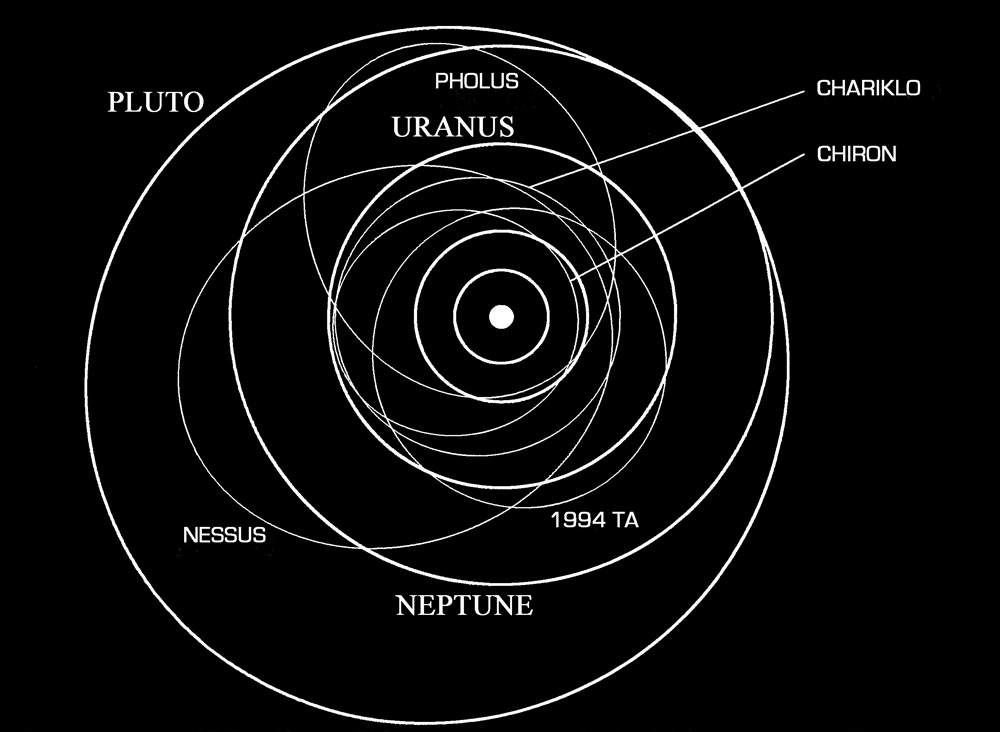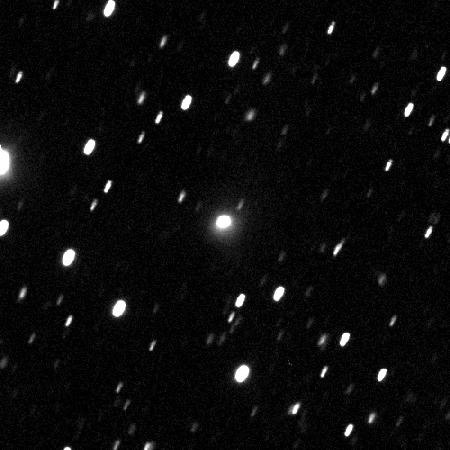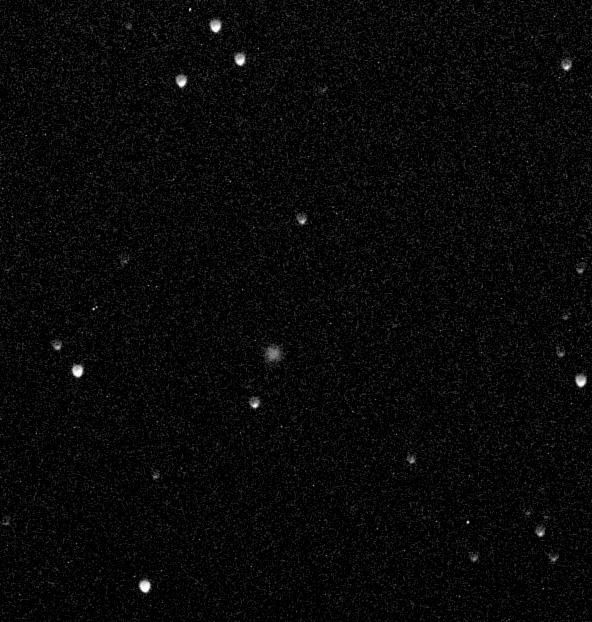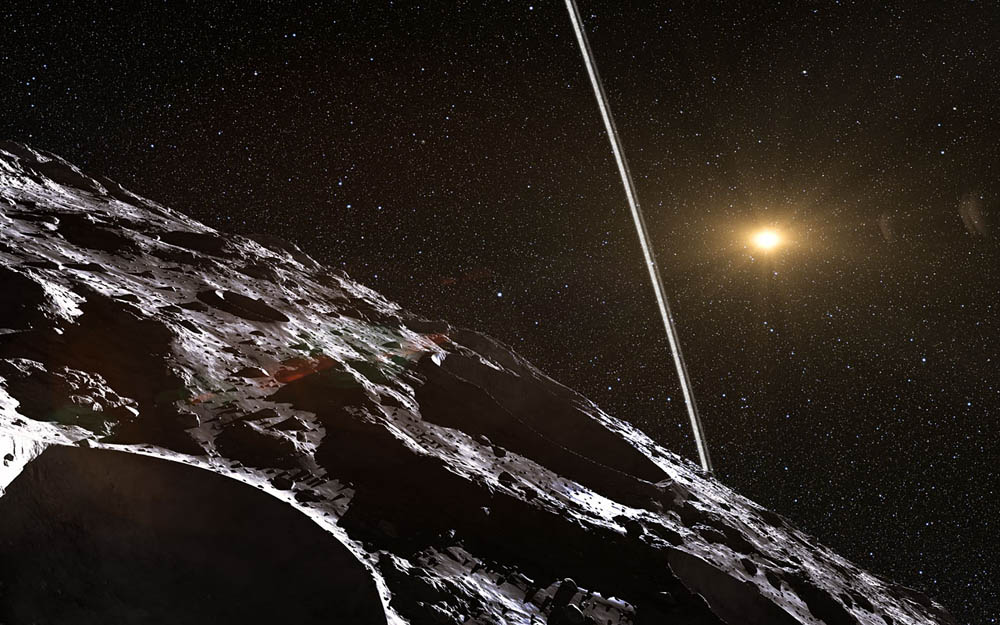

WEEK 7: FEBRUARY 9-15
TOPIC: CENTAURS
In previous “Special Topics” presentations I have focused on asteroid populations in the “main asteroid belt” between Mars and Jupiter, and on asteroids in near-Earth space. If, however, as is now widely believed to be the case, asteroids are among the “leftovers” of the planet formation process, we would accordingly expect asteroids to exist in other regions of the solar system as well.
Between the early 1970s and mid-1980s astronomer Charles Kowal utilized the large 1.2-meter Schmidt telescope at Palomar Observatory in California on a monthly basis, ostensibly to search for objects in the outer solar system. During the course of this program he discovered several near-Earth asteroids, a handful of comets, numerous supernovae in other galaxies (including one of the brightest such objects of the entire 20th Century), and two outer moons of Jupiter. Perhaps his most significant discovery, though, was a stellar-appearing 18th-magnitude object that appeared on Schmidt photographs he took on October 18 and 19, 1977. The object was traveling at the very slow rate of only three arcminutes per day – roughly similar to that of Uranus – which suggested that it was probably located at a similar distance from the sun.
Kowal was soon able to locate images of the object on Schmidt photographs that he had taken in September 1969. With this available data Brian Marsden was able to calculate that Kowal’s object was traveling in an orbit with a moderate eccentricity and an orbital period of approximately 50 years, and in fact was not too far past aphelion at the time of Kowal’s discovery. It would have been at perihelion in the mid- to late 1940s, and shortly thereafter several images of it were found on photographs taken during that era, including a Palomar Schmidt photograph taken in August 1952 as part of the Palomar Sky Survey. William Liller and Lola Chaisson of Harvard Observatory were also able to identify an image of the object taken from Harvard as far back as April 24, 1895, around the time of its previous perihelion passage.
Marsden was now able to calculate that Kowal’s object was traveling in an orbit with an eccentricity of 0.38, an orbital period of 50.7 years, with its heliocentric distances ranging from 8.45 AU – somewhat inside the orbit of Saturn – at perihelion to 18.9 AU – close to Uranus’ average distance – at aphelion. Its heliocentric distance at the time of discovery was 17.8 AU, and it would not reach perihelion until February 1996, over 18 years after Kowal’s discovery. Originally assigned the asteroidal designation 1977 UB, it was soon assigned the number (2060), and Kowal named it “Chiron,” the mythological centaur who was the son of Kronus (Saturn) and grandson of Ouranos (Uranus) – the two planets between which it orbits – and the instructor of many of the Greek heroes. According to the Roman poet Ovid, Chiron is supposedly represented by the southern constellation Centaurus.
Chiron is a relatively large object, with an estimated diameter in the vicinity of 200 km. During the years after its discovery it exhibited periodic brightness variations which indicated a rotational period of 5.9 hours. Around the time it passed through perihelion in 1996 Chiron reached a peak brightness of 15th magnitude and was detectable visually in moderate-sized telescopes.
For the next decade and a half after Chiron’s discovery it pretty much had the outer solar system to itself, at least in terms of known objects of its size. Then, in early 1992, David Rabinowitz with the Spacewatch program in Arizona discovered an object (which was independently found around the same time by Eugene and Carolyn Shoemaker at Palomar), dubbed 1992 AD, that is traveling in an orbit similar to Chiron’s: an orbital eccentricity of 0.57, a period of 92 years, and a perihelion distance of 8.78 AU. Pre-discovery images from 1977 were soon identified, which allowed it be assigned the number (5145) and, in keeping with the precedent established by Kowal, Rabinowitz gave it the name “Pholus,” the mythological centaur who befriended Heracles.
In April 1993 Rabinowitz discovered a third object, 1993 HA2 (now known as (7066) Nessus) with an orbital period of 123 years and a perihelion distance of 11.89 AU, and in October 1994 Jun Chen and David Jewitt at Mauna Kea in Hawaii discovered a fourth one, 1994 TA, with an orbital period of 70 years and a perihelion distance of 11.7 AU. Once the comprehensive surveys became operational a few years later more and more such objects began to be discovered, and it is now clear that an entire population of them exists in the outer solar system. Collectively they are now referred to as “centaurs,” and while there is no precise definition of what exactly constitutes a “centaur,” today approximately 500 of them are now known. It is likely that their total population is at least in the tens to hundreds of thousands.
Ever since Chiron’s discovery, its physical nature – and, more recently, the physical nature of other centaurs – has been a matter of much debate and speculation. At first Chiron behaved more or less like a “normal” asteroid, but as it approached perihelion it started to depart from this. In early 1988 it was over a half-magnitude brighter than expected, and by late that year this difference had grown to a full magnitude. At the same time, the brightness variations that it had long exhibited had all but vanished, suggesting the possibility of a cloud of obscuring material. Then, on April 10, 1989, Karen Meech and Michael Belton detected a coma around Chiron in images taken with the 4-meter telescope at Kitt Peak National Observatory in Arizona. (Subsequent measurements elsewhere indicated that this coma extended as far as 130,000 km from Chiron itself.) Finally, in January 1990 Schelte “Bobby” Bus of Lowell Observatory in Arizona and his colleagues detected the presence of gaseous emissions from Chiron.

 LEFT: Graphical representation of the orbits of Chiron and a few of the other early known centaurs. The innermost planetary orbits shown are those of Jupiter and Saturn. RIGHT: Chiron, with its coma, as imaged with the 4-meter reflector at Kitt Peak National Observatory on March 9, 1992. Courtesy Karen Meech and Michael Belton.
LEFT: Graphical representation of the orbits of Chiron and a few of the other early known centaurs. The innermost planetary orbits shown are those of Jupiter and Saturn. RIGHT: Chiron, with its coma, as imaged with the 4-meter reflector at Kitt Peak National Observatory on March 9, 1992. Courtesy Karen Meech and Michael Belton.
The conclusion was inescapable: Chiron is a comet, albeit a very large and most unusual one. In recognition of this “dual nature,” in 1995 the IAU assigned it the short-period comet designation 95P, although to avoid any kind of confusion it retains the name “Chiron” as opposed to the name of its discoverer.
Since then, a handful of other centaurs have been observed to exhibit cometary activity. Three of these, in fact, were exhibiting such activity around the time of their respective discoveries, and accordingly received short-period comet designations shortly thereafter; one of these, 167P/CINEOS, has the distinction of being the comet with the largest known perihelion distance, 11.79 AU. Comet Tenagra C/2013 C2 also has a centaur-like orbit (orbital period 64 years and perihelion distance of 9.13 AU) and can also be considered a likely member of this class; this object underwent a three-magnitude outburst in February 2015 six months before its perihelion passage.
One of the most interesting “cometary” centaurs is (60558) Echeclus, originally discovered in March 2000 by Jim Scotti with the Spacewatch program; it has an orbital period of 35 years and a perihelion distance of 5.82 AU, and in fact was only a couple of years past perihelion at the time of its discovery. For the next few years its behavior was entirely “asteroidal,” however in late 2005, when it was located at a heliocentric distance of 13.1 AU, Paul Weissman and Young-Jun Choi detected a cometary coma around it in images taken with the 5.1-meter Hale Telescope at Palomar. Despite its large distance this coma was detectable visually at 14th magnitude in early 2006, and meanwhile in early April images taken with the Vatican Advanced Technology Telescope at Mt. Graham Observatory in Arizona showed that this coma had become detached from the nucleus itself.
Echeclus – which received the short-period comet designation 174P in the wake of this outburst – subsequently returned to “normal” not too long thereafter, but since then has undergone three more such outbursts, the most recent (and brightest) of which was in December 2017 when it was 2 ½ years past perihelion and located at a heliocentric distance of 7.3 AU. Based upon the behavior it has exhibited thus far, it is entirely possible that it may continue to exhibit occasional outbursts up through it time it passes through aphelion in late 2032, and beyond.

 (60558) Echeclus (also known as Comet 174P/Echeclus) while in outburst. Left: April 2, 2006, as imaged with the 1.8-meter Vatican Advanced Technology Telescope at Mt. Graham Observatory in Arizona. Courtesy Guy Sonsolmagno, Stephen Tegler, and colleagues. Right: December 12, 2017, imaged with the Las Cumbres Observatory facility at McDonald Observatory in Texas. Echeclus is the small diffuse object just below and left of center.
(60558) Echeclus (also known as Comet 174P/Echeclus) while in outburst. Left: April 2, 2006, as imaged with the 1.8-meter Vatican Advanced Technology Telescope at Mt. Graham Observatory in Arizona. Courtesy Guy Sonsolmagno, Stephen Tegler, and colleagues. Right: December 12, 2017, imaged with the Las Cumbres Observatory facility at McDonald Observatory in Texas. Echeclus is the small diffuse object just below and left of center.
At least one other centaur, (52872) Okyrhoe, has exhibited spectroscopic and photometric behavior that is suggestive of weak cometary activity, and two other ones, (8405) Asbolus and (10199) Chariklo, have shown spectroscopic evidence for the presence of water ice (perhaps due in part to a recent impact crater in the case of Asbolus). On June 3, 2013, meanwhile, Chariklo occulted a background star, and this event revealed that it is accompanied by two small thin rings, possibly created through a collisional event. Incidentally, Chariklo, which was discovered by Scotti in 1997, has a diameter slightly larger than 250 km and is the largest-known confirmed centaur.
Dynamical studies indicate that the orbit of Chiron, and indeed the orbits of centaurs in general, are “chaotic” in the mathematical sense,

In physical terms, centaurs are essentially indistinguishable from objects in the Kuiper Belt, which also exhibit a range of physical characteristics and colorations. Given this and all the other available information about them, it now seems rather clear that the centaurs are a link in the evolutionary progression between Kuiper Belt objects and short-period comets. It seems rather likely, in fact, that most, if not almost all, centaurs are dormant cometary nuclei, with some of them, for example Chiron, being active now and/or at some point in the past, and others, for example Pholus and Nessus, never having yet come close to the sun and thus never having been active. At least some of the centaurs that we are detecting today may eventually become the short-period comets that our descendants may be observing in the centuries and millennia to come.
Indeed, a study published last year by a team led by Gal Sarid at the University of Central Florida concludes that a dynamical “gateway” between centaurs and short-period comets exists just beyond Jupiter’s orbit. A small handful of objects appears to occupy this “gateway” at the present time, by far the most prominent of these being the comet known as 29P/Schwassmann-Wachmann 1. This most unusual comet, which was discovered almost a century ago, is a future “Comet of the Week.”
“Special Topics” archive
Ice and Stone 2020 home page
Earthrise Institute home page